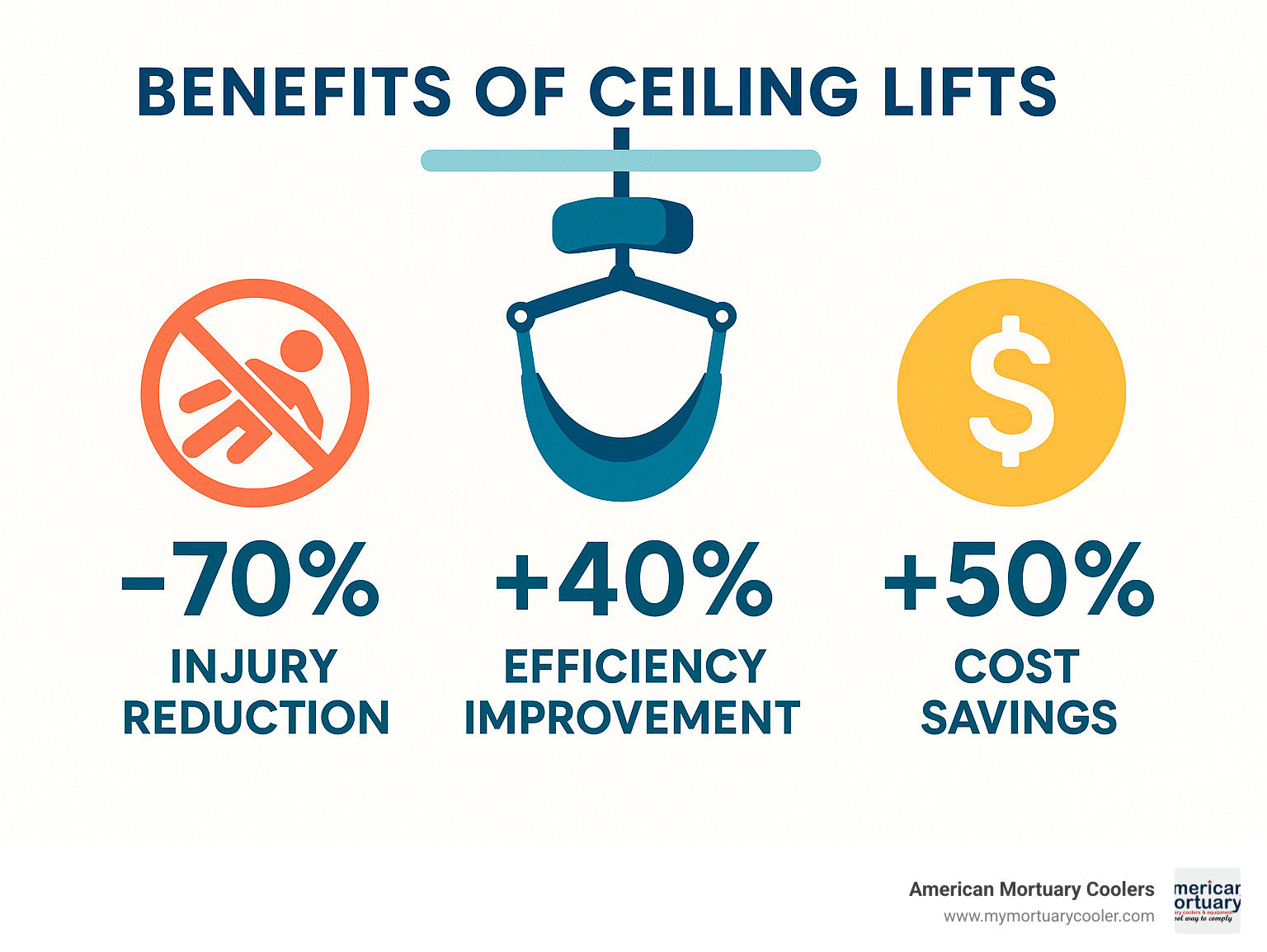Why Understanding Lift Ceiling Systems Matters for Your Facility
A lift ceiling is a ceiling-mounted mechanical system that safely transfers patients, equipment, or objects using motorized hoists and overhead tracks. These systems eliminate manual lifting, reduce caregiver injuries, and maximize usable floor space in healthcare facilities, homes, and specialized environments.
Key Lift Ceiling Benefits:
- Safety: Reduces back injuries by up to 95% compared to manual transfers
- Efficiency: Enables single-handed patient care operations
- Space-saving: Zero floor footprint unlike bulky floor lifts
- Versatility: Fixed motors support up to 1,000 lbs, portable units up to 600 lbs
- Flexibility: Straight, curved, or room-to-room track configurations available
Whether you're looking at patient ceiling lifts for healthcare facilities, projector lifts for hidden AV equipment, or decorative ceiling systems for aesthetic purposes, understanding the basics helps you choose the right solution for your specific needs.
Professional installation is typically required for structural integrity and code compliance, though some portable systems offer more flexibility for multi-room use. The key is matching your lift ceiling system to your facility's specific requirements, budget, and long-term goals.
I'm Mortuary Cooler from American Mortuary Coolers, and I've spent years helping funeral homes and healthcare facilities implement reliable lift ceiling solutions that meet their unique space and operational challenges.
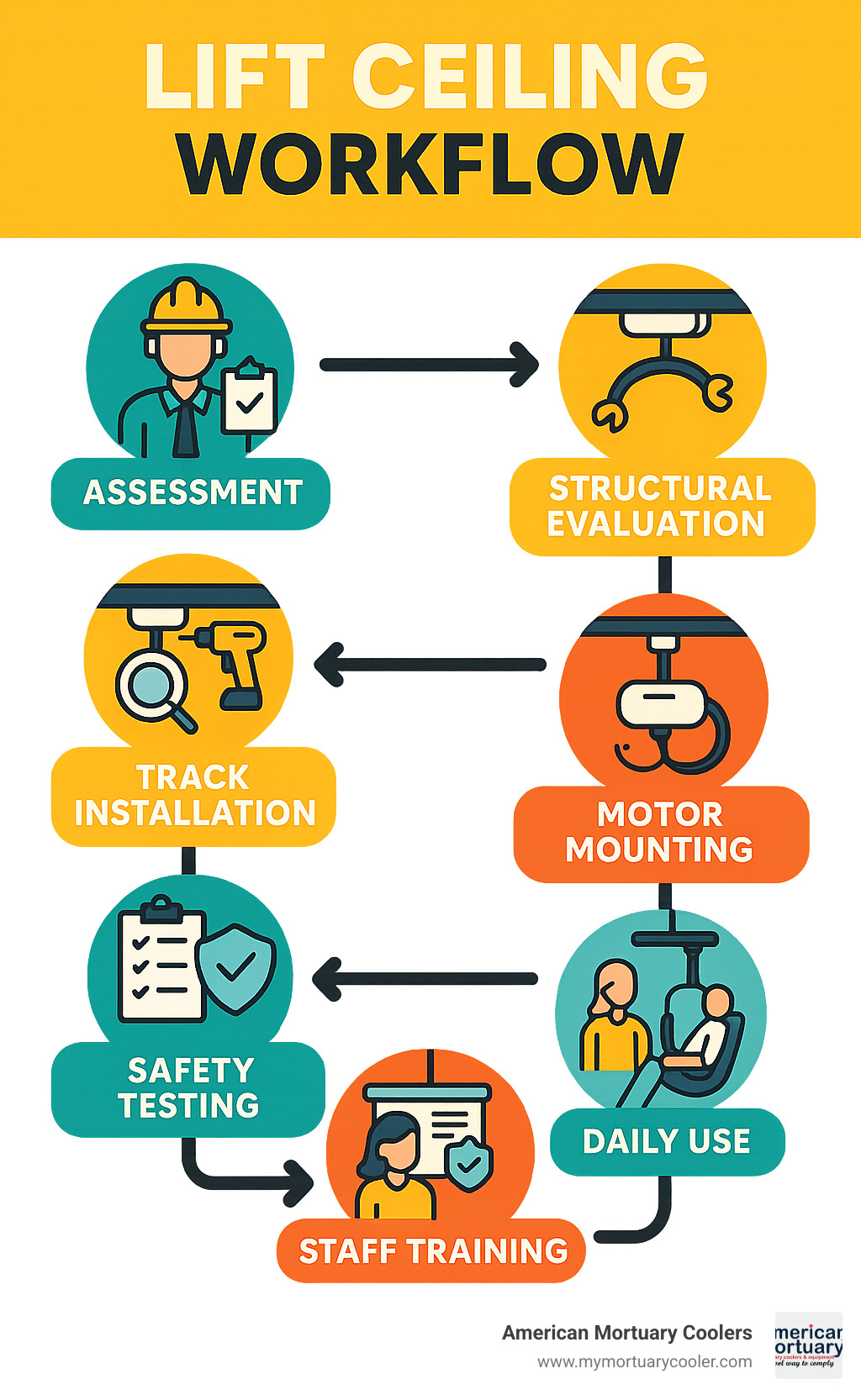
Understanding Lift Ceiling Systems
The story of lift ceiling systems begins decades ago in hospitals where nurses were struggling with back injuries from lifting patients. What started as basic mechanical hoists has evolved into today's sophisticated systems that make transfers safer, more dignified, and surprisingly graceful.
Think of a modern lift ceiling like a well-orchestrated dance. The motor unit serves as the lead partner, providing smooth lifting power. Fixed ceiling lift motors handle up to 1,000 pounds, while portable units manage up to 600 pounds. The rail and track system creates pathways overhead - straight lines, curved paths, or complex room-to-room systems.
The sling and support system ensures comfort and safety with different slings for different needs. The control system puts power in your hands with simple handheld controls featuring up, down, and emergency stop buttons.
But lift ceiling systems aren't just for patient care. Projector lifts hide expensive AV equipment in boardroom ceilings, while decorative ceiling systems create stunning visual effects in restaurants and hotels. In mortuary applications, specialized lifts handle transfers with dignity and respect.
Research shows these systems can reduce injury risk by up to 95% compared to manual lifting. The zero-footprint benefit means your floor space stays yours, with no bulky equipment blocking walkways.
How a Lift Ceiling Operates Step-by-Step
Operating a lift ceiling is straightforward once you understand the basics. Modern battery systems have improved significantly - lithium-ion batteries outperform old lead-acid ones, lasting longer and charging faster. Many systems include smart features like auto-shutoff and constant-charge options.
The lifting happens through a motorized winch system. When you press the handset controls, the motor engages smoothly with variable speed settings and emergency lowering capabilities.
A typical transfer flows like this: position the sling comfortably, secure attachment points, lift to clear obstacles, glide along the track, then lower gently into place. The process maintains dignity while keeping everyone safe.
What Is a Lift Ceiling & Why It Beats Floor Lifts
When comparing transfer options, lift ceiling systems offer clear advantages. Manual lifting puts caregivers at risk and requires multiple people. Floor lifts take up precious space and can be awkward around furniture. Wall-mounted lifts save some floor space but limit mobility and weight capacity.
Lift ceiling systems provide full room coverage, maximum weight capacity, and zero floor clutter. Healthcare facilities report major drops in worker compensation claims after installation. The space gained back is substantial - floor area previously occupied by bulky equipment becomes available for storage or improved traffic flow.
Choosing the Right Ceiling Lift: Types, Features & Comparisons
When selecting the perfect lift ceiling system, understanding your options makes the choice much clearer.
Fixed motor systems are the workhorses, permanently mounted units handling up to 1,000 pounds. They're built to last in busy places like hospitals and nursing homes. Portable motor systems offer flexibility with 600-pound capacity, letting you move one motor between different rooms by switching between track sections.
Tarzan swing systems solve room-to-room movement, letting you transfer smoothly between spaces, even under doorways, without extending tracks or modifying door frames.
Beyond patient care, projector lifts hide bulky AV equipment in ceiling spaces, while decorative stretch ceiling systems transform spaces with integrated lighting and visual effects.
Load ratings vary widely. Standard patient lifts handle 600-1,000 pounds, while specialized equipment can exceed these capacities. Sling varieties include full-body slings for complete transfers, toileting slings for bathroom visits, and stand-assist slings for those who can bear some weight.
Battery technology has improved dramatically. Lithium-ion batteries outperform older models with longer runtime, faster charging, and extended life. Constant-charge systems keep lifts ready for emergencies.
| Feature | Fixed Motor | Portable Motor | Floor Lift |
|---|---|---|---|
| Weight Capacity | Up to 1,000 lbs | Up to 600 lbs | 400-600 lbs |
| Floor Space | Zero footprint | Zero footprint | Significant footprint |
| Multi-room Use | No | Yes | Yes |
| Installation Cost | High | Medium | Low |
| Flexibility | Low | High | High |
Lift Ceiling Options for Home & Facility Settings
Home installations bring unique considerations. Lift ceiling systems in bedrooms and bathrooms need to respect privacy while providing safety. Portable systems shine here - one motor can serve multiple rooms as needs change.
Bathroom installations require waterproof motors and stainless steel tracks that won't rust. Modern compact designs squeeze full functionality into surprisingly small spaces.
Rehabilitation gyms benefit from extensive track networks. Patients can move independently between therapy stations, contributing enormously to recovery. Bariatric wards demand the strongest systems available, often exceeding 1,000 pounds capacity.
In mortuary applications, ceiling lifts provide respectful handling while protecting funeral home staff. Mortuary Lifts, Cadaver Lifts, Ceiling Lifts: Choosing the Right System offers detailed guidance for funeral professionals.
Key Features Checklist Before You Buy
Weight capacity tops every shopping list. Calculate your maximum anticipated load including the person plus any medical equipment, then add 20% as a safety buffer.
Ceiling structure assessment requires professional evaluation. Standard construction might need reinforcement to safely support lift loads. Motor IP ratings indicate water exposure tolerance - IP54 for indoor use, IP65 for direct water exposure.
Emergency lowering capabilities provide controlled descent during power outages. Auto shut-off features prevent motor damage while extending battery life. Warranty coverage and service network availability affect long-term satisfaction.
Insurance reimbursement can dramatically reduce costs. Medicare, Medicaid, and private insurance often cover medically necessary installations.
Installation & Maintenance Essentials for Safe Ceiling Lifts
Getting your lift ceiling system installed properly creates a foundation of safety that will serve you for years. The journey starts with a thorough site survey examining structural capacity, electrical needs, and daily usage patterns.
You'll likely need a structural engineer to evaluate whether your ceiling joists can handle the load and determine if reinforcement is needed. Track layout planning creates pathways that make transfers smooth and dignified. Straight runs keep things simple, while curved sections work around architectural features.
Most installations need reinforcement work - adding blocking between joists or installing steel reinforcement plates to distribute weight. Mounting points must spread force across multiple structural members.
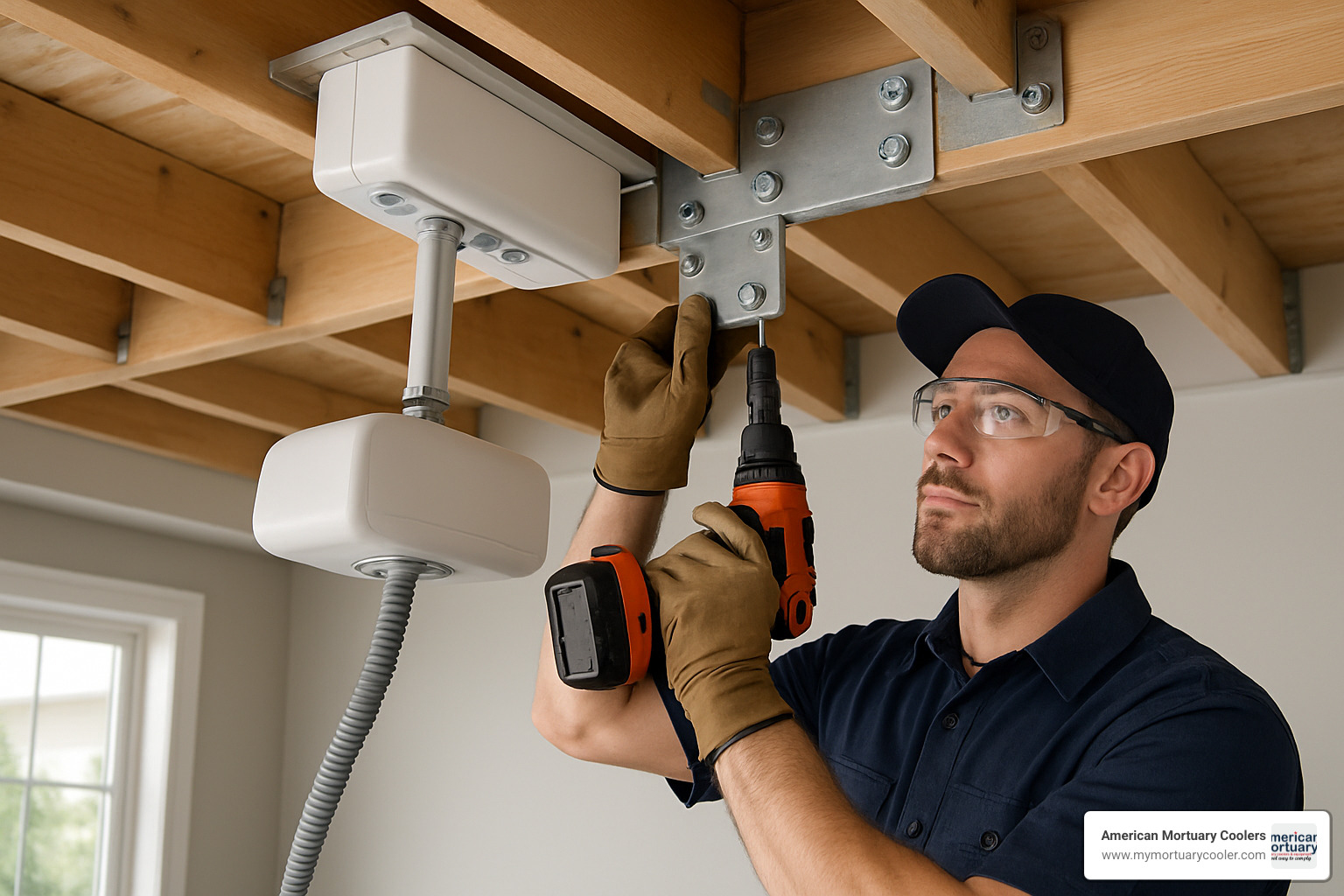
Certified technicians should handle structural modifications and electrical connections. These professionals have training and certification to do the job right while keeping warranties intact.
Building codes govern installations, especially in commercial settings. ADA compliance ensures accessibility, while OSHA regulations protect workers. Local codes might add additional requirements.
Once operational, maintenance becomes crucial. Battery checks keep everything running, while proper sling laundering maintains hygiene. That annual load test verifies your system can still handle maximum loads safely.
Keep detailed records of installation paperwork, maintenance logs, and inspection reports. When ready for professional installation, reach out to specialized installers who understand ceiling lift requirements.
DIY Prep vs Professional Installation
Permits are your first reality check. Simple home installations might only need electrical permits, but commercial projects typically require structural reviews. Professional installers carry insurance and certifications that protect you from liability risks.
The tool requirements alone make a strong case for professional installation - specialized lifting equipment, structural fasteners, and electrical testing devices cost more than most want to invest for one-time use.
Time estimates vary by complexity. Simple residential systems might take one day, while complex commercial installations can stretch over several days. Professional installation often comes out ahead when you factor in volume discounts and efficiency.
Common Lift Ceiling Challenges & Fixes
Door thresholds are classic stumbling blocks for room-to-room systems. Tarzan swing systems solve this by enabling transfers under doorways without track extensions. Low ceilings limit options and might force specialized low-profile systems.
Obstructions like ductwork and lighting fixtures love to appear where you want tracks. Early identification during planning allows for design modifications. Battery failure tops operational headaches - regular charging schedules and proactive replacement prevent most failures.
Sling misfit creates comfort and safety issues. Proper initial sizing prevents most problems, while regular inspection catches wear before it becomes dangerous.
Design, Cost & Environment Considerations
When planning your lift ceiling installation, the design doesn't have to scream "medical equipment." Color-matched rails can disappear into your ceiling, painted to match existing schemes. Some manufacturers offer tracks that tuck into decorative molding.
Recessed projector lifts hide expensive projection equipment completely out of sight. Press a button, and your projector descends smoothly for presentations, then vanishes back into the ceiling. Stretch fabric ceilings create seamless, beautiful surfaces that conceal tracks while offering over 100 color options.
Quality lift ceiling systems operate whisper-quiet, especially important in bedrooms or patient care areas.
The budget conversation includes total cost of ownership - initial purchase, professional installation, ongoing maintenance, and eventual replacement. Purchase versus rental depends on usage frequency. For daily transfers, buying makes sense. For occasional use, rental programs save money upfront.
Medicare and Medicaid reimbursement can cover substantial portions of medically necessary installations with proper documentation. Healthcare facilities often see dramatic reductions in worker compensation claims, making these systems pay for themselves within a few years.
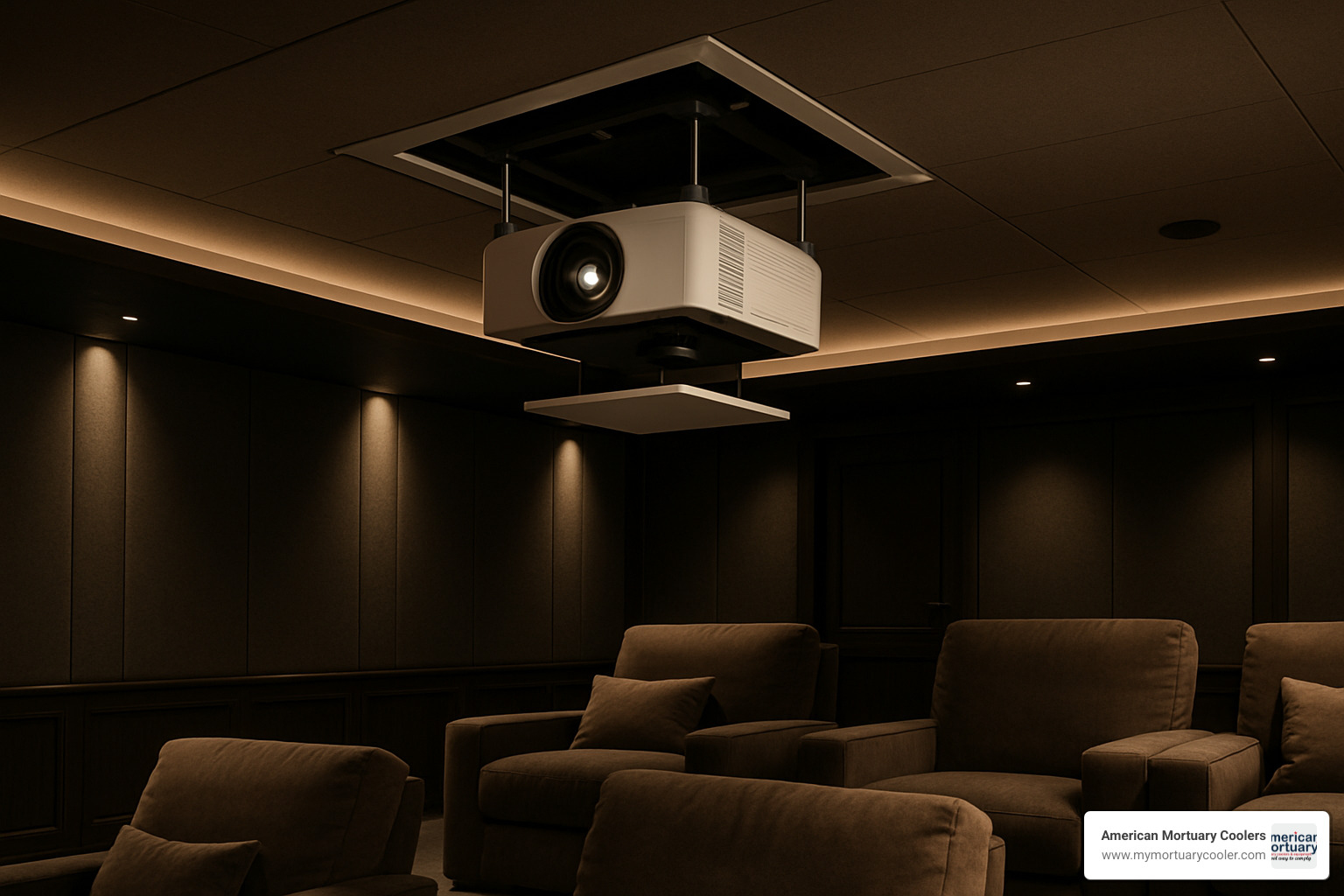
Fixed Budget? Portable Lift Ceiling Solutions
Portable lift ceiling systems deliver professional-grade performance while maximizing equipment investment through flexibility. Instead of buying separate motors for each room, one high-quality portable motor serves multiple track sections.
Modern quick-release mechanisms make motor deployment simple - no tools required. Staff can relocate motors between rooms in under two minutes. The cost-per-transfer math often favors portable systems when usage is moderate.
Special Environments: Bathrooms, Pools, Mortuaries & Beyond
Specialized environments demand unique lift ceiling solutions. Waterproof motors with proper IP ratings handle humidity and direct water exposure. Stainless steel tracks resist corrosion while maintaining structural integrity.
Pool hoist conversion opens aquatic therapy possibilities with specialized slings and mounting systems for safe water entry.
In mortuary applications, lift ceiling systems require utmost respect and dignity. Equipment must handle transfers with complete gentleness while protecting staff from injury. Lift and Chill with These Reliable Mortuary Fridge Lifters provides detailed information about specialized mortuary lifting equipment.
Infection-control materials become critical in healthcare and mortuary settings. Antimicrobial coatings and smooth surfaces allow thorough cleaning while preventing bacterial growth.
Innovations, Standards & Quick-Fire FAQs
The lift ceiling industry continues evolving with technological advances. IoT monitoring systems provide real-time equipment status and predictive maintenance alerts, tracking usage patterns and mechanical wear to prevent failures.
Voice control integration allows hands-free operation, enabling independent use for individuals with limited hand function. Antimicrobial coatings prevent bacterial growth on frequently touched surfaces.
Industry standards ensure safety and compatibility. ISO 10535 governs patient lifting equipment design and testing. CE marking indicates European compliance, while UL listing confirms North American safety standards.
Caregiver training apps provide interactive education on proper lift techniques and safety procedures, improving training consistency while reducing instructor time requirements.
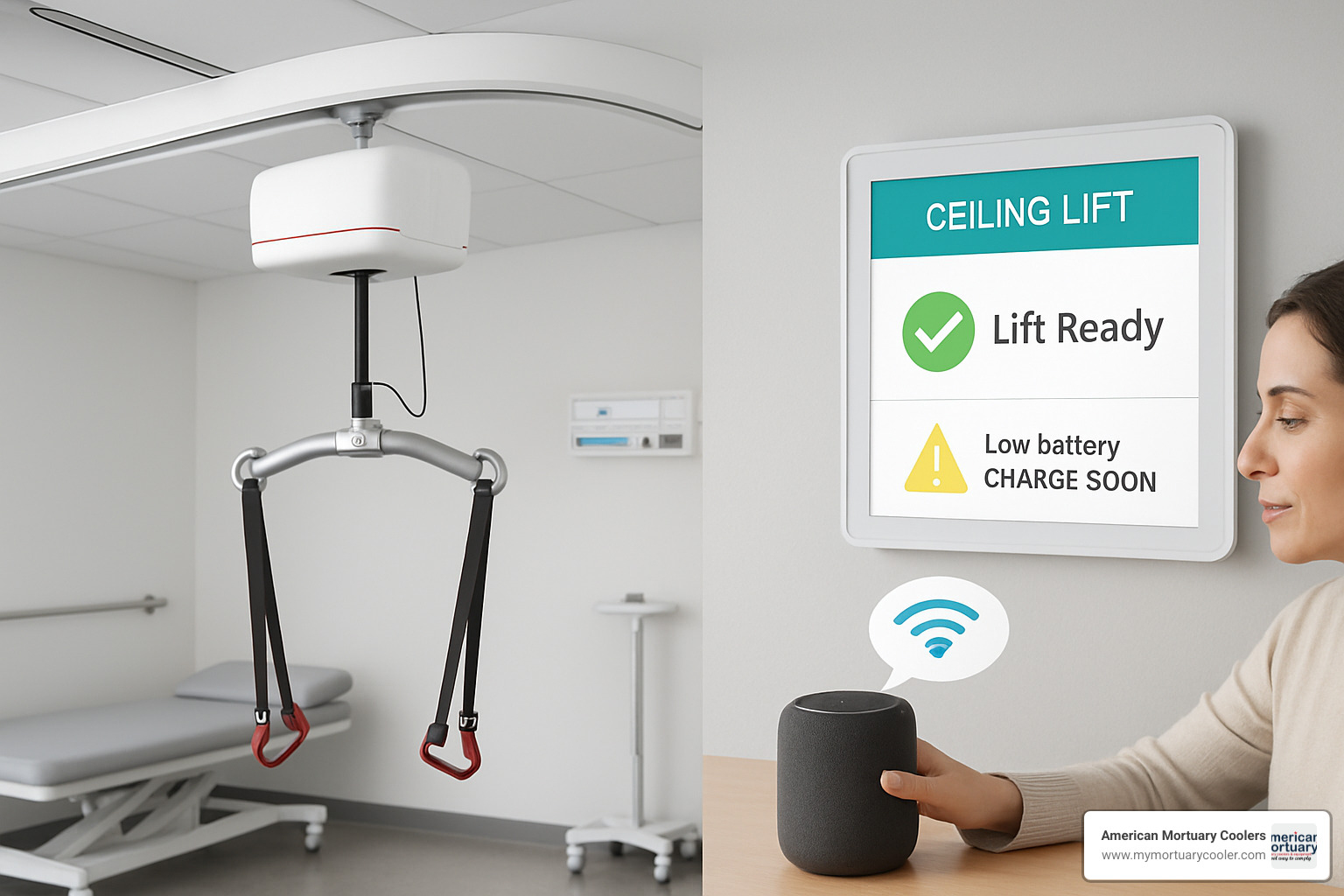
Frequently Asked Questions About Lift Ceilings
1. What weight can a typical lift ceiling handle?
Fixed ceiling lift motors can safely handle up to 1,000 lbs, making them perfect for hospitals and nursing homes that need reliable heavy-duty lifting daily.
Portable ceiling lift motors offer more flexibility with capacity around 600 lbs, which covers the vast majority of transfer needs while giving you freedom to move the motor between rooms.
You need to plan for more than just the person's weight. Dynamic loading during transfers can temporarily spike forces well above static weight. We always recommend adding at least a 20% safety margin to your expected maximum load.
In our specialized mortuary work at American Mortuary Coolers, we often deal with situations where standard capacities aren't enough. Bariatric applications and mortuary systems can exceed typical ranges because dignity and safety don't have weight limits.
2. How long do batteries last between charges?
Battery life in lift ceiling systems varies depending on usage frequency and battery type. Modern lithium-ion batteries typically provide 20-40 transfers per charge under normal conditions - usually enough for several days of regular home use.
Older lead-acid batteries don't last as long between charges but cost less upfront. Auto-shutoff features prevent power drain when not actively used, extending battery life significantly.
For facilities needing lifts ready at a moment's notice, constant-charge systems keep batteries topped off. Heavy-use environments might need nightly charging, while occasional home use could go several days or weeks between charges.
3. Can one lift ceiling cover multiple rooms?
Absolutely! Portable lift ceiling systems can serve multiple rooms with just a single motor unit. You install track sections in each needed room but only buy one motor. The portable motor easily detaches and reattaches wherever needed next.
Most modern systems feature quick-release mechanisms that make this process tool-free and take just minutes. Tarzan swing systems offer another solution, letting you transfer between adjoining rooms by swinging under doorways without track extensions.
Fixed ceiling lift systems stay put but offer higher weight capacity (up to 1,000 lbs versus 600 lbs for portable units) and they're always ready. For occasional transfer needs or tight budgets, portable systems provide professional-grade capability without multiple motor costs.
Conclusion
Choosing the right lift ceiling system can truly transform how your facility operates. Whether you're running a funeral home, healthcare facility, or specialized care environment, these systems protect your staff while maintaining dignity for those you serve.
Safety comes first, always. Professional installation isn't just recommended - it's essential for protecting everyone who depends on these systems.
At American Mortuary Coolers, we've been helping facilities across the country find the right solutions for over a decade. From our home base in Tennessee, we've delivered custom lift ceiling systems to funeral homes nationwide. Each facility has unique needs, and that's exactly how we approach every project.
Start small, think big. Most successful installations begin with one high-use area. Once your staff experiences the difference a quality ceiling lift makes, expansion becomes the natural next step.
Facilities report dramatic reductions in worker injuries, improved efficiency, and better staff satisfaction after installing ceiling lift systems. One funeral director told us his workers' compensation claims dropped to zero after installation.
Routine maintenance keeps everything running smoothly. Battery checks, track cleaning, and annual inspections prevent small issues from becoming big problems. Establish maintenance schedules from day one.
Looking ahead, lift ceiling technology keeps improving. Voice controls, smart monitoring, and improved battery life are making these systems more user-friendly than ever.
Planning makes perfect. Before you buy anything, get a professional assessment of your structural needs, electrical requirements, and workflow patterns. This upfront investment pays dividends in smoother installation and better performance.
Our custom solutions approach means we work with your specific situation. Low ceilings? Tight spaces? Unusual weight requirements? We've handled it all. More info about American Mortuary custom solutions shows how we tackle unique challenges with practical solutions.
The funeral industry deserves equipment that works as hard as the people in it. Lift ceiling systems represent more than mechanical assistance - they're about protecting your most valuable asset: your team.
